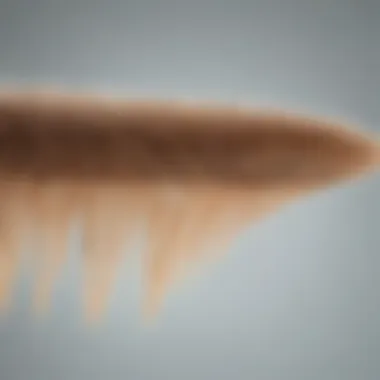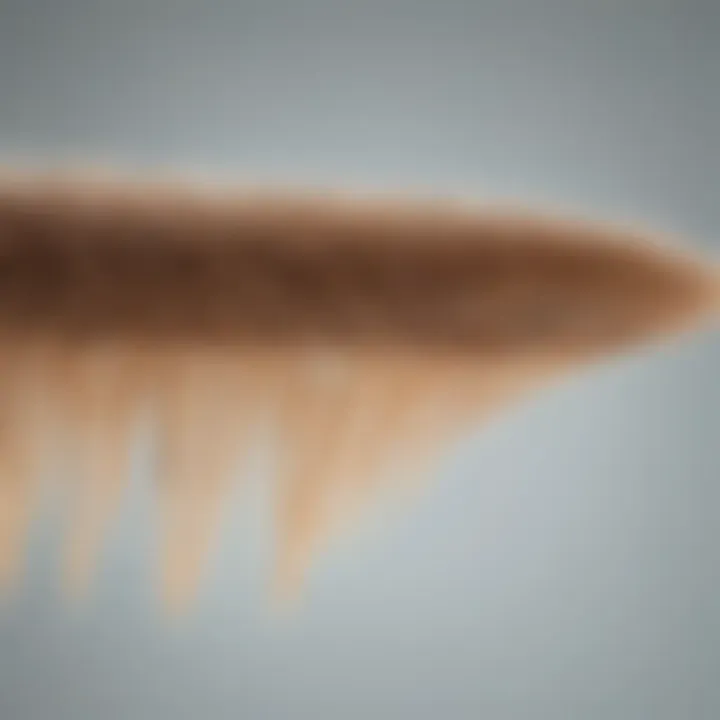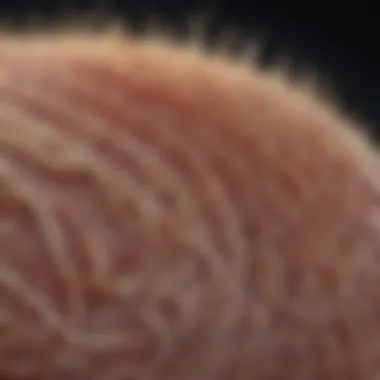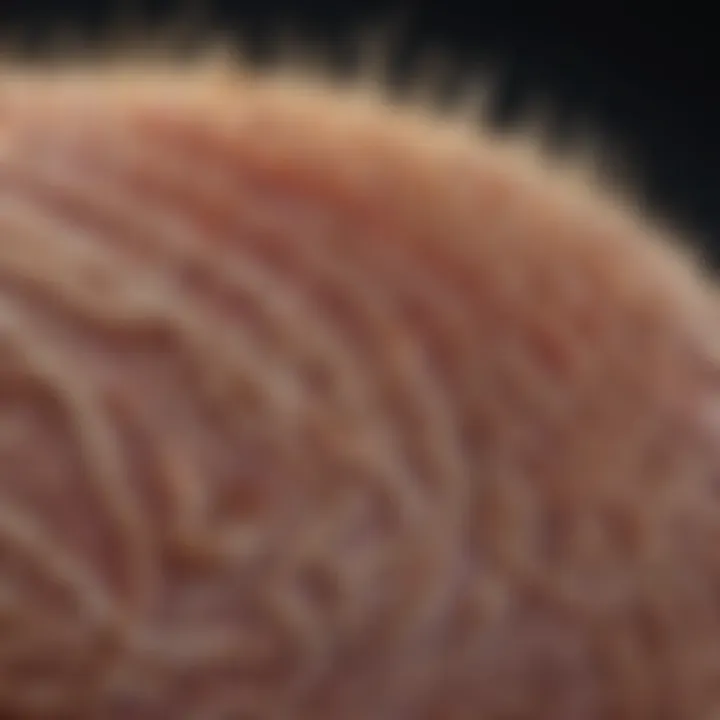Understanding Hair Growth: Mechanisms and Influences


Article Overview
Purpose of the Article
The intention of this piece is to peel back the layers of complexity surrounding hair growth, a process often taken for granted. Hair, while trivial to some, plays a pivotal role in personal identity and even psychological well-being. Every strand that sprouts, each wayward hair that seems to have a mind of its own, factors into a larger biological narrative. This article aims to inform readers about the various intricacies at play, from cellular mechanisms to hormonal fluctuations, shedding light on how these elements intertwine to shape our hair’s life cycle.
Relevance to Multiple Disciplines
Understanding hair growth spills into various fields including biology, dermatology, and even psychology. For researchers, dissecting the processes involved in hair production opens up pathways to innovations in hair restoration techniques. In the realm of psychology, the significance of hair in self-image and identity cannot be overstated. Hence, professionals from diverse domains will find valuable insights within these discussions.
Research Background
Historical Context
For centuries, hair has been a subject of fascination among cultures worldwide. From the ancient Egyptians who deemed hair sacred to the modern-day beauty standards dictated by celebrity culture, hair's role has always been multifaceted. Scientific exploration into hair growth began gaining traction in the 19th century, setting the stage for what would become a vast field of study. Historical texts have documented various anatomical insights, but it wasn’t until the late 20th century that molecular biology began revealing the deeper biological and genetic underpinnings of hair growth.
Key Concepts and Definitions
To navigate this topic, it's crucial to grasp a few core concepts:
- Anagen Phase: The active growth phase of hair, where cells divide rapidly.
- Catagen Phase: Transition phase that signals hair growth cessation, lasting a short period.
- Telogen Phase: The resting phase, where hair remains in a dormant state before eventual shedding.
- Androgens: Hormones that can influence hair growth, particularly in conditions like androgenic alopecia.
As we delve deeper into this subject, it will become clear how these phases and terms interplay and what roles they play in both healthy and disrupted hair growth processes.
"Hair growth is not just a biological function; it is a tapestry of genetic, hormonal, and environmental interactions."
"Hair growth is not just a biological function; it is a tapestry of genetic, hormonal, and environmental interactions."
Understanding these elements sets the foundation for grasping how hair growth is impacted not just by personal biology, but also by external factors such as stress, nutrition, and cosmetic use. By the end of this exploration, readers will be equipped with a holistic understanding of hair growth and the myriad factors influencing it.
An Overview of Hair Biology
Understanding hair biology serves as the foundation for delving into the complexities of hair growth. Hair is more than just a physical adornment; it plays significant roles in both health and social identity. Throughout this section, we'll highlight pivotal aspects of hair composition and structure, which are essential for grasping how hair grows and the factors affecting its health.
Composition of Hair
Hair is primarily composed of keratin, a resilient protein that is also found in skin and nails. This fibrous protein contributes to the strength and durability of hair strands. But hair is not just keratin; it also contains water, lipids, and a mix of minerals, making it a multifaceted structure.
- Water: Accounting for about 10-15% of hair's composition, it maintains moisture and flexibility.
- Lipids: These fats help to create a barrier, sealing in moisture and providing sheen.
- Minerals: Elements like zinc, copper, and iron support hair follicle health.
Each of these components has a role, impacting the overall appearance and condition of hair. Healthy hair typically showcases shine and resilience; however, any imbalance can result in dryness or brittleness.
Structure of Hair Follicles
Beyond its composition, understanding the structure of hair follicles is crucial. Hair follicles are complex mini-organs residing beneath the skin surface, housing the machinery necessary for hair growth.
A hair follicle can be broadly divided into several parts:
- Dermal Papilla: At the base, this section is interwoven with blood vessels, providing essential nutrients for hair cell production.
- Outer Root Sheath: The first line of defense, helping to protect the internal structures of the follicle.
- Inner Root Sheath: This sheath shapes the growing hair and assists with keratinization.
- Matrix: Located at the bulb area, the matrix contains actively dividing cells crucial for new hair formation.
This architecture explains why follicles can be sensitive to various internal and external influences, including hormonal changes and environmental factors. Understanding this structure not only helps explain normal hair growth patterns but also elucidates why conditions such as hair loss occur.
"The intricate relationship between a follicle’s structure and its biological functions is a testament to the complexity of our body’s systems."
"The intricate relationship between a follicle’s structure and its biological functions is a testament to the complexity of our body’s systems."
By piecing together the information on composition and structure, we establish a solid basis for exploring the hair growth cycle and its multifaceted influences, making clear the significance of hair biology in both personal identity and overall health.
The Hair Growth Cycle
The hair growth cycle is a foundational concept in understanding how hair develops and regrows. It's not simply about hair coming in and out of our head; it’s a synchronized process governed by complex biological mechanisms. Throughout this cycle, factors like hormones and genetics play pivotal roles. Knowing the ins and outs of the cycle allows researchers, students, and medical practitioners to better grasp both normal hair functioning and abnormalities that may arise.
In essence, the hair growth cycle is divided into three main phases: Anagen, Catagen, and Telogen, each with its own specific characteristics and timelines.
- Anagen Phase: This is the prime time for hair, where growth is bustling like a busy city street.
- Catagen Phase: The transitional phase is a bit like a traffic light turning yellow—indicating that changes are underway.
- Telogen Phase: This is the downtime, akin to resting at home after a long day.
Understanding the nuances of each phase sheds light on various hair conditions. Let’s dive deeper into these phases to capture their distinct features and implications for hair health.
Anagen Phase: The Growth Phase
The Anagen phase is the heart of the hair growth cycle. During this active phase, hair follicles are in high gear, creating the hair shaft and pushing it up from the scalp. This phase can last anywhere from two to six years depending on genetic factors and overall health. Individuals with longer Anagen phases often enjoy thicker, longer hair, while those with a shorter duration might find their hair is more prone to breakage or stunted growth.
Energized by a rich supply of nutrients, hair follicles actively produce keratinocytes, the cells responsible for hair growth. This phase is influenced significantly by metabolism and overall health, making proper nutrition essential. Key nutrients like biotin, zinc, and vitamins A and E help fortify the process.
"The Anagen phase is where the magic happens; it's the cornerstone of hair growth and is deeply influenced by one’s lifestyle and health."
"The Anagen phase is where the magic happens; it's the cornerstone of hair growth and is deeply influenced by one’s lifestyle and health."


Catagen Phase: Transitional Stage
The Catagen phase serves as a bridge, representing a transition from growth to dormancy. Lasting approximately two to three weeks, this phase sees hair growth slow down. The hair follicle shrinks, and the lower part of the hair shaft is released from the blood supply; it is essentially a preparatory period for the next phase. Think of it as a cocktail party winding down—the excitement lessens, but it's not quite over yet.
During this phase, some hair follicles deactivate while others remain active, leading to a phenomenon known as the 'hair shedding cycle,' where old hairs fall out to make room for new growth. It's here that the body's hormone fluctuations may play a noticeable role, as imbalances can affect the timing and duration of Catagen.
Telogen Phase: The Resting Stage
The Telogen phase is where hair takes a breather. Lasting about three months, this resting stage allows hair follicles to pause before embarking on the next growth cycle. At any given time, around 10-15% of hair is in this phase, awaiting the moment to spring back into action.
During Telogen, hair isn’t completely inactive; however, it can be shed quite easily due to factors like hair washing, styling, or friction caused by hats and pillowcases. After this period, the hair follicles prepare to reenter the Anagen phase, restarting the growth journey. Factors such as stress, illness, or poor nutrition may impact how efficiently the cycle continues.
In summary, the hair growth cycle isn't merely about hair falling out and growing back again. It's a complex interplay of stages that are sensitive to various factors, including genetics, health, and lifestyle choices. Understanding this cycle is crucial for anyone looking to enhance hair health or address specific hair-related issues.
Cellular Mechanisms in Hair Growth
The cellular mechanisms underlying hair growth play a pivotal role in how hair forms, develops, and renews itself throughout a person’s life. Understanding these mechanisms provides valuable insight into the complexities behind hair biology and highlights the factors that influence hair density, texture, and health. Markedly, these processes are not merely biological curiosities; they are fundamental to addressing hair-related disorders and developing effective treatments for conditions such as alopecia or thinning hair.
Keratinocytes and Hair Formation
Keratinocytes are specialized skin cells that produce keratin, a crucial protein in hair, skin, and nails. These cells are the heavyweights in the battle for hair health. They originate in the epidermis—the outermost layer of skin—and play a significant role within the hair follicle itself. When hair follicles are stimulated during the anagen (growth) phase, keratinocyte proliferation ramps up, paving the way for hair shaft formation.
The relationship between keratinocytes and other cells in the follicle is essential for hair growth. For instance, fibroblasts, another type of cell found in the dermal papilla, provide signals that encourage keratinocytes to differentiate and produce keratin. This collaboration between cells fosters the creation of a robust hair shaft, one that retains its structure and strength.
Additionally, keratinocytes are responsive to various signaling molecules and growth factors. For example, the epidermal growth factor (EGF) and insulin-like growth factor (IGF) are known to enhance keratinocyte proliferation and promote hair growth. Neoformative studies suggest targeting these pathways could yield new hair restoration treatments aimed at stimulating keratinocyte activity.
Stem Cells in Hair Follicles
An essential player in hair growth is the population of stem cells nestled within hair follicles, particularly in the bulge region. These stem cells are responsible for the regeneration and continual cycling of hair follicles. When activated, they can differentiate into multiple cell types needed for hair formation, including keratinocytes that directly contribute to the hair shaft.
The activation of these stem cells can be triggered through various mechanisms, including hormonal changes, injury, or environmental factors. They enter a state of proliferation during the anagen phase, providing a reservoir of new cells that drive hair growth continually. A particularly interesting twist is how stem cells can adapt their functions based on the body's needs, illustrating a level of sophistication akin to a highly skilled chameleonic performer.
Moreover, research has identified that stem cells in hair follicles are influenced by external signals like Wnt and Hedgehog pathways. These signaling pathways orchestrate the activation and maintenance of stem cells, thereby shaping the hair growth cycle. Disruptions in these mechanisms might contribute to hair loss, making it a focus of intense research, as understanding these pathways could lead to revolutionary hair growth therapies.
"Disruptions in the hair follicle’s stem cell environment may result in hair loss, presenting an essential research avenue to restore healthy hair growth."
"Disruptions in the hair follicle’s stem cell environment may result in hair loss, presenting an essential research avenue to restore healthy hair growth."
Through a grasp of both keratinocytes and stem cells, we gain fresh insights into hair biology. A comprehensive understanding of these cellular mechanisms opens doors to innovative treatments and effective strategies for individuals seeking to navigate hair growth disorders. Engaging with this knowledge highlights the significance of biological research in the realm of hair health, presenting it not just as a cosmetic concern, but as a profound facet of human biology.
Genetic Influences on Hair Growth
Genetic influences on hair growth represent a captivating intersection of biology and individuality. Hair growth is not merely a byproduct of health or external factors; it's deeply intertwined with one's genetic make-up. Understanding these influences sheds light on the complexities of hair biology and why people experience variations in hair density, texture, and even patterns of loss.
Genetics is significant, because it explains why some individuals seem to grow lush, full heads of hair, while others may struggle with thinning or patchy areas. Variations in hair growth can often be traced back to specific genes and their expressions. Researchers have identified multiple genes associated with hair characteristics, suggesting that our ancestry significantly shapes our hair’s destiny.
Hereditary Traits and Variations
Hereditary traits play a crucial role in determining hair growth patterns. Family history can reveal much about what to expect in terms of growth and loss. For instance, if both parents experienced hair thinning, the likelihood of their children facing similar challenges is increased. This scenario often points towards polygenic inheritance, where several genes collectively influence the trait, making it a complicated puzzle to unravel.
Some common hereditary traits include:
- Hair texture: Straight, wavy, or curly hair is influenced by genetic variations in the keratin proteins, which are integral components of hair.
- Color variations: Genes determine the type and amount of melanin produced, affecting hair color diversity.
- Growth patterns: The pattern of hair loss or thinning is also hereditary, with studies indicating that androgenetic alopecia, commonly known as male or female pattern baldness, can be inherited from either side of the family.
Beyond these visible traits, genetics can also inform how hair responds to environmental factors. For example, certain genetic profiles may confer resilience against damage from UV exposure, while others might predispose an individual to increased brittleness and fragility.
Genetic Disorders Affecting Hair Growth
Various genetic disorders can profoundly impact hair growth, leading to conditions that can affect both physical appearance and self-esteem. These disorders might be manifest from birth or develop later in life due to changes in gene expression. Some of the notable disorders include:
- Alopecia Areata: An autoimmune disorder where the body's defense system mistakenly attacks hair follicles, leading to hair loss in patches. Gene variations in immune response pathways are often implicated in this condition.
- Ichthyosis: A genetic condition affecting skin and, consequently, hair, causing them to be dry and scaly, making hair brittle and prone to breakage.
- Androgenetic Alopecia: As mentioned earlier, this common condition is linked to genetic predispositions, particularly in response to androgens like testosterone.
Genetic influence on hair growth is not just limited to loss; individual’s responses to treatments are also tied to their genetic make-up. Some individuals may find certain hair loss treatments more effective than others, a difference that can often be traced back to genetics.
Genetic influence on hair growth is not just limited to loss; individual’s responses to treatments are also tied to their genetic make-up. Some individuals may find certain hair loss treatments more effective than others, a difference that can often be traced back to genetics.
Overall, unraveling the role of genetic influences on hair growth is paramount for a thorough understanding of hair biology. It helps explain the variations we observe among individuals while underscoring the need for personalized approaches to hair care and treatment.
Hormonal Regulation of Hair Growth
Hair growth is influenced by a multitude of factors, and among them, hormonal regulation plays a critical role. Hormones like androgens, estrogen, and progesterone are not just abstract concepts; they are the messengers that convey specific instructions impacting hair follicles and their behavior. Understanding hormonal influences can be pivotal in both grasping the complexity of hair growth and in addressing conditions that can lead to hair loss or abnormal growth patterns. Hair growth is not a one-size-fits-all process, and hormonal regulation introduces significant variations in the growth cycle that are influenced by age, gender, and overall health.
Role of Androgens
Androgens—such as testosterone and its more potent derivative, dihydrotestosterone (DHT)—are significant players in hair biology. These hormones have a dual function: they can stimulate hair growth in certain areas of the body, like facial and body hair, while inhibiting growth in others, particularly on the scalp. In individuals genetically predisposed to androgenetic alopecia, the effects of DHT can lead to shrinking hair follicles, resulting in thinning or hair loss.
In men, the higher levels of testosterone contribute to a more vigorous growth of facial hair and body hair during puberty. However, the same hormone can have a negative impact on scalp hair by shortening the anagen phase of the hair growth cycle.
A Deeper Look at Androgens


- Anabolic Effects: Promoting thicker and coarser hair in certain regions like the chest and beard.
- Sensitivity: Not all hair follicles react the same way to androgens. Genetic factors determine how hair follicles respond to DHT, explaining why some individuals experience more hair loss than others.
Androgens are crucial to understanding male-pattern baldness and female-pattern hair loss. What's interesting is that while hair loss is often inherited, lifestyle choices, medical conditions, and hormonal imbalances also play a role in how androgens exert their effects on hair follicles.
The role of androgens in hair growth illustrates the complexity of biological systems, where balance can mean the difference between lush locks and bald patches.
The role of androgens in hair growth illustrates the complexity of biological systems, where balance can mean the difference between lush locks and bald patches.
Effects of Estrogen and Progesterone
On the other side of the hormonal spectrum, estrogen and progesterone present a different narrative regarding hair growth. These hormones are the stars of the show during puberty and pregnancy, contributing to the thicker and healthier hair often reported by women during these phases. Estrogen plays an essential role in prolonging the anagen phase, leading to increased hair density and promoting overall scalp health.
In particular, estrogen tends to protect against the effects of androgenic hormones. During times of hormonal fluctuations—such as menopause or after childbirth—women may notice considerable changes in hair volume and characteristics. The drop in estrogen levels during menopause is often associated with an increase in hair shedding and thinning.
Distinct Functions of Estrogen and Progesterone
- Modulating Hair Growth: Estrogen can counteract the hair-thinning effects of androgens, promoting longer hair growth cycles.
- Effects on Scalp Health: Progesterone can influence sebum production, impacting hair follicles and the condition of the scalp. Too little sebum can lead to dry hair and cause brittleness.
Understanding these hormonal dynamics is integral for anyone studying hair biology or looking to unravel the complexities of hair disorders. The interrelation between androgens and estrogens affects not just the quantity of hair but also its quality, turning a seemingly straightforward biological process into a nuanced conversation filled with implications for health and beauty.
Environmental Factors Affecting Hair Growth
Understanding the different environmental factors that influence hair growth is essential to grasp the broader aspects of hair health and aesthetics. External elements can significantly impact both the structure and the growth cycle of hair, sometimes resulting in unwanted changes.
Here are two crucial areas to consider: nutrition and pollution, each of which carries its weight concerning the hair's vitality and appearance.
Impact of Nutrition on Hair Health
Nutrition plays a fundamental role in hair growth. What we consume does not just affect our overall health but also contributes directly to the state of our hair. Ingredients, such as vitamins and minerals, are vital for maintaining robust hair follicles. Biotin, iron, zinc, and vitamins A, C, D, and E are especially critical. Diets low in these nutrients can lead to weakened hair that is prone to breakage or, worse, hair loss.
A balanced approach to eating could include:
- Lean proteins: Essential for keratin production, a major component of hair.
- Leafy greens: Full of iron and vitamins that support blood circulation to the scalp.
- Nuts and seeds: Packed with minerals that promote hair strength.
To sum it up, ensuring that your diet is rich in these nutrients creates a nourishing environment for hair to thrive. Neglecting nutrition could lead to hair that feels lifeless and looks dull, reflecting poor internal wellbeing.
Effects of Pollution and Climate
Another significant environmental influence is pollution and climate conditions. Urban dwellers often grapple with the harmful effects of air and water pollutants that can clog hair follicles and lead to a slew of scalp-related issues. These pollutants can degrade hair’s stability, affecting not only growth but also hair texture over time. The effects are often compounded by climate factors such as humidity and temperature, which can exacerbate conditions like frizz or oiliness.
For instance, consider the following points:
- Pollution exposure: Tiny particles can accumulate on the scalp, leading to irritation or inflammation, potentially hindering hair growth.
- Humidity levels: High humidity can create an excess of sebum, while dry air can lead to brittleness.
- Temperature extremes: Cold and windy weather can strip moisture from hair, leaving it dry and lifeless.
"Just like how the environment shapes a garden, it can heavily influence hair health—what thrives and what withers is often a reflection of its surroundings."
"Just like how the environment shapes a garden, it can heavily influence hair health—what thrives and what withers is often a reflection of its surroundings."
In light of this, it is important to protect your hair from environmental stressors, through proper care, using protective styles, or simply washing it more frequently in polluted areas.
Overall, environmental factors play a vital role in hair’s health and growth potential. Understanding how nutrition and various environmental influences shape our hair can empower individuals to make informed choices for enhanced hair health.
Disorders Affecting Hair Growth
Understanding disorders that affect hair growth is crucial for both individuals suffering from these conditions and for professionals involved in treatment and research. Hair loss and growth disorders not only impact physical appearance but can also lead to significant psychological distress. It is essential to recognize the variety of conditions that exist, their underlying mechanisms, and available treatments. This exploration provides insights into how these disorders can be identified and managed effectively, aiding not only in medical understanding but also in personal care and psychosocial well-being.
Alopecia: Forms and Treatments
Alopecia is a broad term encompassing various types of hair loss. The most common type, androgenetic alopecia, often referred to as male or female pattern baldness, is hereditary in nature and impacts a large segment of the population. This condition typically presents itself gradually, with a recognizable progression in hair thinning and eventual baldness.
However, alopecia isn't just confined to this genetic predisposition. There are several other forms worth mentioning:
- Alopecia Areata: This autoimmune condition causes sudden, patchy hair loss. The body's immune system mistakenly targets hair follicles, leading to hair loss in localized areas.
- Alopecia Totalis: A more severe manifestation where all scalp hair is lost.
- Alopecia Universalis: This form leads to a complete loss of all body hair.
Treatment options vary depending on the type and severity of alopecia. Typically, regrowth is targeted through:
- Topical Treatments: Minoxidil is a commonly prescribed solution that encourages hair regrowth. While it can be effective for many, results can vary.
- Corticosteroid Injections: These are often employed for conditions like alopecia areata, aiming to reduce inflammation and modulate the immune response.
- Oral Medications: Finasteride may be prescribed for androgenetic alopecia, particularly in men, by inhibiting the hormone responsible for hair loss.
- Hair Transplantation: For persistent cases, surgical options like Follicular Unit Extraction or Strip Surgery may be considered, where healthy hair follicles are transplanted to balding areas.
Ultimately, understanding alopecia and its various forms is crucial in selecting appropriate treatments tailored to individual needs. The psychosocial impact of hair loss also cannot be overstated, making it essential for those affected to seek both medical and emotional support.
Other Hair Growth Disorders
Beyond alopecia, other disorders impede normal hair growth, which can be equally challenging. Conditions such as telogen effluvium, where hair follicles prematurely transition to the resting stage due to stress or physical illness, can cause significant shedding. Unlike other forms of hair loss, this condition is often reversible once the underlying cause is addressed.
Furthermore, some people may experience hypotrichosis, a condition characterized by inadequate hair growth since birth or beginning in childhood. The causes range from genetic mutations to environmental factors, and while treatments are limited, they predominantly focus on managing expectations and enhancing existing hair retention.
It's also important to mention hirsutism, which involves excessive hair growth in women in areas where men typically grow hair, like the face and chest. This condition often stems from hormonal imbalances, primarily involving androgens. Addressing the root cause, often through hormonal therapy, can help mitigate unwanted hair growth.


Innovative Research in Hair Biology
Innovative research in the field of hair biology could be viewed as a beacon of hope for those grappling with hair loss or related disorders. The ever-evolving landscape of this research is crucial, as it enhances our understanding of the complex processes that govern hair growth, while also unveiling potential solutions for common hair problems. The recent developments within this domain showcase how scientific endeavors provide insights not only for treatment pathways but also for our broader understanding of cellular mechanisms and genetic influences.
Research in this area is not just about improving hair health; it dives deep into the biological intricacies and mechanisms behind hair growth. Moreover, it intertwines with various medical fields, potentially transforming patient care. As technology advances, it paves the way for more personalized and targeted therapies. This adaptability can lead to better outcomes, especially for individuals who might not have responded to conventional treatments.
"Hair growth is a subject that intertwines biology, technology, and personal identity, making the research both vital and multidimensional."
"Hair growth is a subject that intertwines biology, technology, and personal identity, making the research both vital and multidimensional."
Recent Advances in Hair Restoration Techniques
In recent years, hair restoration techniques have undergone significant transformations, largely driven by advancements in technology and a deeper understanding of hair biology. Traditional methods—like hair transplants—continue to evolve, incorporating newer techniques aimed at improving the efficacy and minimizing the invasiveness of the procedure.
One notable advance is the development of Follicular Unit Extraction (FUE). This minimally invasive technique allows for individual hair follicles to be harvested and transplanted, leading to less scarring compared to traditional strip methods. The increased artistry involved in FUE means practitioners can create a more natural-looking hairline, which is crucial for patient satisfaction.
In addition to FUE, the introduction of robotic-assisted hair restoration has brought precision to the harvesting process. Robots can reduce human error, allowing for more consistent results. This technology breaks down the hair restoration procedure into smaller, repeatable tasks, improving accuracy and decreasing trauma to the scalp.
The usage of platelet-rich plasma (PRP) therapy has become another groundbreaking development in hair restoration. This method utilizes the patient's own blood, from which platelets are extracted and injected into the scalp. This enriched plasma contains growth factors that promote hair regeneration and strengthen existing follicles, leading to noticeable hair improvement over time.
Emerging Therapies in Hair Growth
Emerging therapies in hair growth are pushing boundaries, exploring solutions that extend beyond traditional treatments. One area of exciting research includes the use of stem cell therapy. Scientists believe that harnessing the regenerative properties of stem cells could lead to breakthroughs in treating hair loss. The idea is to cultivate these cells and inject them into the scalp, potentially revitalizing dormant hair follicles and stimulating fresh hair growth.
Another promising avenue involves nutraceuticals—natural compounds that have been suggested to promote hair health. Certain vitamins and minerals, like biotin and zinc, have gained popularity not just in hair care but also within the broader scope of health and wellness. Continued research into specific formulations could lead to products that more effectively support hair growth at the cellular level.
Furthermore, advancements in genetic therapies could yield revolutionary treatments for hereditary hair loss. By directly targeting the genes that influence hair growth, researchers are investigating ways to modify or restore normal hair growth pathways that may be disrupted in conditions like androgenetic alopecia.
Innovative research in hair biology represents a vibrant and evolving intersection of science and personal care. As these techniques and therapies advance, individuals facing hair-related challenges might find renewed hope through ever-innovative treatment options.
Cultural Perspectives on Hair Growth
The interface between hair and culture runs deep, entwining aspects of identity, tradition, and social constructs. Understanding hair growth through a cultural lens contributes significantly to grasping its biological nuances. The social significance of hair often transcends its physiological aspects, becoming a potent symbol of personal and communal identity.
Hair and Identity
Hair is not merely a biological structure; it embodies various meanings across different contexts. For many, it symbolizes individuality, heritage, and even resistance. In many cultures, hairstyles can signify one's social status or role in a community. For instance, among the Maasai, the intricate braiding and adornment of hair reflect a person's age, marital status, or clan affiliation. In contrast, the shaved heads worn by certain religious communities symbolize humility and devotion.
The connection of hair to identity often invokes the phrase, “Your hair tells your story.” This concept resonates through personal experiences where individuals express their cultures or affiliations by adopting specific hairstyles. Take, for instance, the historic significance of Afro-textured hair in the Black community. It has served as both a statement of pride and a rejection of Eurocentric beauty standards. The act of choosing to wear natural hair can be seen as a reclamation of one’s identity in a society that often favors straight or Eurocentric styles.
Moreover, in contemporary media, hair is frequently used as a metaphor for personal change. When characters undergo transformations, their hairstyles often shift, visually signaling their internal development. This line of thought emphasizes how hair continues to serve as a dynamic reflection of personal identity, highlighting individual autonomy while also illustrating broader sociocultural themes.
Historical Views on Hair Care
Delving into the past, the history of hair care unveils an array of fascinating practices that vary dramatically across cultures and epochs. Ancient civilizations often ascribed potent meanings to hair, influencing their hair care routines. For example, the Egyptians revered hair and developed a range of treatments, including scented oils and dyes, reflecting not just aesthetics but also spiritual beliefs.
Moving forward in history, the Victorian era presents another striking perspective on hair. Women’s hair was seen as a quintessential aspect of femininity, often requiring intricate styles that reflected societal expectations of beauty. These standards affected how women cared for their hair, leading to the rise of specific products and techniques tailored for this purpose. Nevertheless, women also faced significant pressure to conform to these ideals, which at times resulted in damaging practices meant to achieve the desired appearance.
Today, hair care has evolved into a flourishing industry with a global following. The availability of products tailored to various hair types and conditions signifies an increasing awareness of diversity. However, along with inclusivity, comes the paradox of beauty standards perpetuated through media and advertising, which can create unrealistic expectations.
“Hair, in its myriad forms, has served as both a canvas and a battleground for cultural expression and conformity.”
“Hair, in its myriad forms, has served as both a canvas and a battleground for cultural expression and conformity.”
Thus, understanding cultural perspectives on hair growth not only enriches our knowledge of personal and collective identities but also illustrates how historical contexts shape our current views on hair care and societal standards.
Culmination: The Future of Hair Research
The exploration of hair biology stands at an exciting crossroads, blending cutting-edge science with an ever-expanding understanding of human biology. As we look towards the future of hair research, it becomes vital to emphasize several key elements, benefits, and considerations that shape this field.
First off, the advancements in genetic studies continue to unravel the complexities of hair growth. With genomic sequencing becoming more accessible, researchers can pinpoint specific genes associated with hair growth disorders. Such insights not only enhance our understanding of hereditary factors but also pave the way for personalized treatment options tailored to an individual’s genetic makeup.
Moreover, the ongoing research into hormonal regulation underscores the importance of this aspect in hair biology. Understanding the intricate balance of hormones like androgens and estrogens—and how their fluctuations impact hair growth—can lead to more effective therapies for conditions influenced by hormonal changes, such as androgenetic alopecia.
Additionally, the surge in biotechnological innovations brings new hope for those experiencing hair loss. From stem cell therapies to the application of growth factors, these technologies promise to revolutionize how we approach hair restoration, expanding the possibilities beyond traditional methods.
Another important angle to consider is the societal implications of hair research. As we deepen our understanding of the factors influencing hair growth, we can address the stigmas surrounding hair loss and promote a more inclusive view of beauty that celebrates diversity in hair types and styles.
Additionally, as researchers gain a clearer picture of the biological mechanisms behind hair, they encounter community needs and cultural perspectives, which then feed back into how research is conducted and its applications.
"As scientific advancements continue to unfold, nurturing an ethical framework is imperative to ensure that the progress benefits all segments of society."
"As scientific advancements continue to unfold, nurturing an ethical framework is imperative to ensure that the progress benefits all segments of society."
In summary, future hair research is set to expand our horizons in ways previously unimagined. By emphasizing genetic insights, hormonal understanding, innovative technologies, and cultural dynamics, we can truly doctor a holistic approach to hair health in the years to come. The need of the hour isn't just scientific advancement; it's a conscious effort to bridge gaps between science and society, ensuring that discoveries in hair biology translate into real-world benefits for everyone.
Implications for Science and Society
The future of hair research holds significant implications, touching on aspects both scientific and societal. For starters, the development of more targeted therapies not only promises enhancements in treatment success rates but also influences the economic landscape by introducing lucrative avenues for pharmaceutical companies and research institutions.
On a broader scale, increasing awareness about hair health can lead to educational initiatives that empower individuals with the knowledge to care for their hair effectively. This aspect is particularly relevant in today’s misinformation-laden information ecosystem, where clarity can make a difference.
Lastly, recognizing diverging cultural attitudes toward hair can foster a greater sense of community, bridging gaps between people and diminishing stigmas associated with various hair conditions.
In essence, the implications of advancing hair research extend beyond the lab into the heart of societies, shaping perceptions, values, and ultimately, the quality of life for individuals across the globe.



